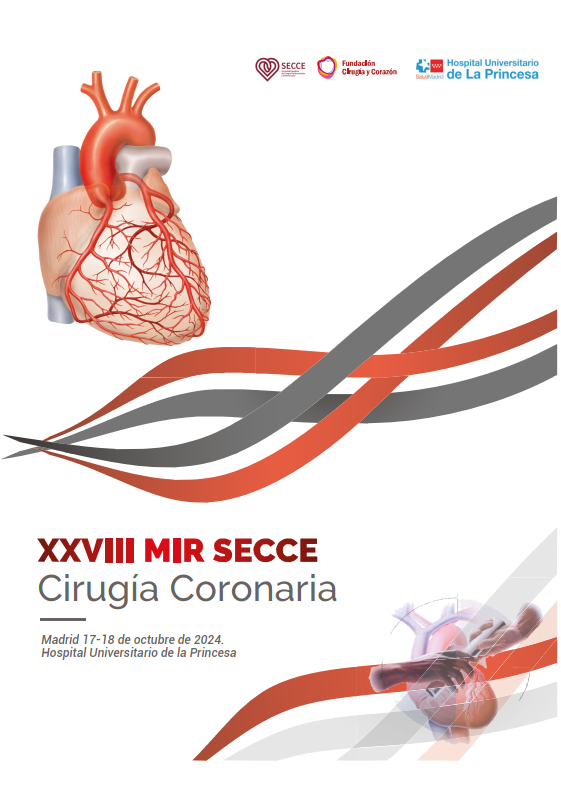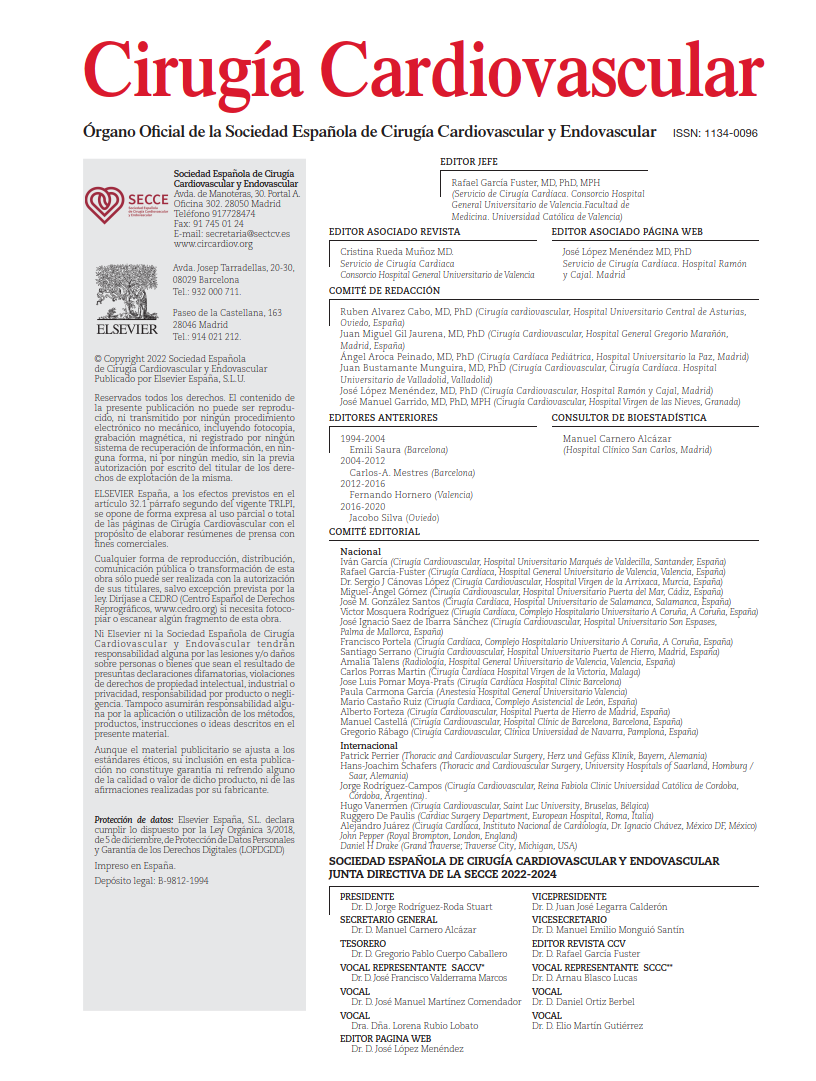The recent publication of long-term follow-up data from the SWEDEHEART registry represents compelling evidence in support of the sustained clinical value of surgical myocardial revascularization. Coinciding with the imminent release of the 2023 annual report from the Spanish National Cardiovascular Surgery Registry, it is noteworthy that, for the first time in its history, the in-hospital mortality rate following CABG has fallen below 2%, reaching 1.7%. Even lower mortality has been observed in centers performing off-pump surgery, with rates slightly above 1%. These figures position the outcomes of Spanish centers on par with the highest international standards. Given the historical downward trend, further improvements may be anticipated in the forthcoming 2024 data, albeit with the expected reporting delay.
The SWEDEHEART registry has established itself as a cornerstone in the field of coronary surgery due to its extensive sample size, methodological rigor, and continuous follow-up. It also provides direct comparisons with PCI. Drawing from over half a million patients recorded in the Swedish national health database, the present subanalysis focuses on patients presenting with non–ST-segment elevation myocardial infarction (NSTEMI). In this context, clinical practice guidelines consistently recommend early coronary angiography—within 72 hours of presentation—after stabilization and in the absence of ongoing ischemia, followed by in-hospital revascularization. The decision between PCI and CABG should be guided by the same principles applied to stable angina, particularly because this subgroup is underrepresented in pivotal randomized trials such as EXCEL, NOBLE, FREEDOM, and BEST. To date, no dedicated randomized controlled trial has been conducted specifically in this population, despite the fact that NSTEMI represents one of the most common clinical scenarios requiring revascularization in contemporary practice.
To address this gap, the SWEDEHEART registry provides valuable observational evidence. A total of 57,099 patients were enrolled and assigned to either surgical revascularization (n = 14,907; 26.1%) or PCI (n = 42,190; 73.9%), based on clinical and anatomical characteristics assessed by a multidisciplinary heart team. Consequently, patients in the PCI group were generally older and had a higher prevalence of prior cardiovascular events. In contrast, those referred for CABG more frequently had diabetes mellitus, hypertension, left main or three-vessel coronary artery disease, and reduced left ventricular ejection fraction. This distribution suggests appropriate patient selection through multidisciplinary evaluation. However, substantial variability was observed in the proportion of patients assigned to PCI across the 30 participating centers, ranging from 57% to over 86%. Such heterogeneity in the management of a common clinical condition has also been reported in other healthcare systems, including the United Kingdom and Italy.
Despite the favorable outcomes associated with CABG, as detailed below, the proportion of NSTEMI patients undergoing PCI increased progressively over time. Between 2007 and 2020, PCI utilization rose from approximately 65% to a peak of 77%, a trend likely influenced by the COVID-19 pandemic but generally consistent with adjacent years.
After a median follow-up of 7.1 years, PCI was associated with higher risks of all-cause mortality (OR = 1.67) and recurrent myocardial infarction (OR = 1.51). Stroke incidence did not differ significantly between the two groups, with overlapping Kaplan–Meier curves and no evidence of early hazard in the surgical cohort. The need for repeat revascularization was over threefold higher in the PCI group. Similarly, the risk of developing heart failure was 15% greater with PCI compared to CABG. Long-term survival at 15 years favored surgery, particularly among patients under 70 years of age, those with left main disease, and those with reduced left ventricular ejection fraction. These differences remained statistically and clinically significant across all follow-up intervals, with ORs ranging from 1.40 to 1.75, depending on the year of assessment between year 1 and year 10.
In summary, the authors reaffirm the superiority of CABG over PCI in patients with surgical indications and NSTEMI, emphasizing adherence to guideline-directed indications, particularly in patients with an estimated life expectancy exceeding 5 years.
COMMENTARY:
Surgical myocardial revascularization—much like structural heart interventions today—has historically engaged in intense competition with percutaneous techniques. The advent of drug-eluting stents, successive device generations, randomized trials, and physiological lesion assessment tools cast serious doubts on the future role of coronary surgery, even as it evolved toward less invasive approaches and broader use of arterial grafts. Today, however, the balance appears more stable, with an approximate 1:3 ratio between CABG and PCI in patients with NSTEMI—a benchmark that, unfortunately, remains far from being achieved in many settings.
The robust real-world evidence provided by the SWEDEHEART registry, along with similarly encouraging national data, should serve as a catalyst for rethinking clinical practice. It is time to promote shared decision-making based on multidisciplinary heart team discussions rather than defaulting to ad hoc strategies, where patients are often “captured” in the cath lab under the pressure of procedural momentum. The Swedish registry demonstrates how this structured approach not only results in significant gains in life expectancy and quality of life but also improves healthcare efficiency. Patients who undergo CABG require significantly fewer repeat revascularizations and generate fewer downstream costs from heart failure.
It is worth reflecting on the persistent absence of a randomized trial specifically targeting this patient group. One may speculate whether this aligns with the strategic wisdom of Sun Tzu’s The Art of War: “If you cannot win, avoid the battle.” Indeed, patients with NSTEMI—among the most frequent and relevant presentations of ischemic heart disease—continue to be managed based on extrapolated evidence from unrelated clinical contexts. Tailoring trial design to match anticipated outcomes, a practice increasingly common today, raises ethical concerns. And yet, returning to Sun Tzu’s logic, perhaps the current asymmetry favors CABG so clearly that avoiding the trial altogether is, in itself, a strategic move. In the meantime, findings from the SWEDEHEART registry—and from national datasets such as ours—should serve as motivation not only to persist but to advocate for practice grounded in long-term benefit rather than short-term convenience.
REFERENCE:
Omerovic E, Råmunddal T, Petursson P, Angerås O, Rawshani A, Jha S, et al. Percutaneous vs. surgical revascularization of non-ST-segment elevation myocardial infarction with multivessel disease: the SWEDEHEART registry. Eur Heart J. 2025 Feb 7;46(6):518-531. doi: 10.1093/eurheartj/ehae700.



